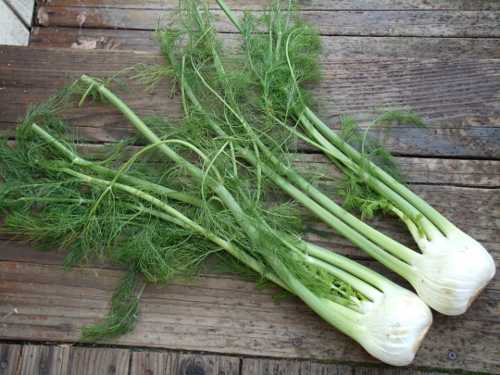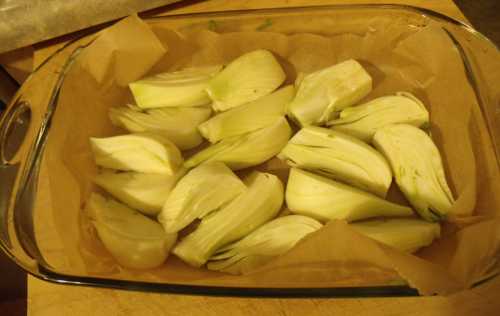
I’ve been a bit obsessed with fennel lately.
A few weeks back I noticed a white bulbous vegetable with feathery green fronds in a local supermarket and thought, “Ah, they have fennel!” Much to my surprise, it was labeled anise.
Doubting my own produce identification skills, I promptly went home and did a bit of research. According to the Internet and my reference books, what I saw was, in fact, fennel. The mislabeling of this somewhat unusual flora set off a flurry of investigation on my part to see what other markets called it.
Of the five or more markets I visited (both here and in Napa and Sonoma counties), only one correctly identified fennel as fennel. The other markets called it either anise or, in one case, sweet anise.
Fennel and anise do have some similarities, perhaps spawning the misnomer.
While they’re members of a different genus, they’re both from the same plant family, apiaceae. Along with licorice, they share the aromatic compound anethole, so have similar, licorice-like tones in their flavor profiles.
As well, both have lacey flower heads made up of many smaller blossoms, and both have edible seeds.
The difference is that with anise, only the seeds are used in cuisine, while all parts of the fennel plant are eaten: root, stalk, leaves and seeds.
Anise seeds are used to flavor many traditional European cookies, such as Italian pizzelle or British aniseed balls, and a variety of liquors throughout the world, including Greek ouzo and French absinthe.
To further complicate matters, anise can sometimes be confused with a Chinese spice, star anise, which, though unrelated, contains the same aromatic compound and strongly resembles it in flavor. Star anise is the beautiful star-shaped seed pod of an evergreen tree.
And don’t confuse Chinese star anise with Japanese star anise, which looks similar, but is poisonous.
In short, since anise roots are not sold as food, feel confident that any bulbous roots so labeled in your local market are fennel in disguise.

Fennel grows wild in most parts of temperate Europe, but is generally considered indigenous to the shores of the Mediterranean region, where it spreads eastward to India. A hardy perennial, it’s closely related to parsley, carrots, dill and coriander.
The dried seeds of the fennel plant (or, more correctly, its fruits) are used in Italian cuisine (it’s a favorite for flavoring sausages), and function as a key ingredient in a variety of spice blends, such as Indian curry, Herbs de Provence and Chinese five spice.
They’re used to flavor savory breads such as rye, as well as sweet baked treats, in much the same way anise seeds are.
The Puritans dubbed fennel the “meeting seed” and chewed it during their long church services to ensure fresh breath. It’s often chewed after a meal in India and Pakistan to ward off indigestion.
Fennel pollen has become popular in recent years as a sweeter, intensified alternative to infusing fennel flavor into dishes. Since it takes many blossoms to make a small amount of pollen, this spice is almost as costly as saffron. Thankfully, only a minuscule amount is needed because its flavor is strong.
Fennel leaves strongly resemble those of dill weed; however, unlike dill, their flavor is quite mild, with the barest hint of anise-like flavor. They can be sniped into a salad or used as a garnish to add bright color to soup.
The Greeks and Romans enjoyed chewing on the fennel stalks, considering them a sweet treat. Along with the foliage, the stalks make a wonderful bed for baking fish, which is one of fennel’s favorite flavor pairings.

Fennel bulbs are mild and crunchy, with an almost sweet flavor and celery-like texture. Adding them raw to salads is my favorite way of using the bulb, and with the abundance of fennel in my home in recent weeks, I’ve enjoyed many a salad topped with thinly sliced pieces of this mild root. I’ve discovered that my favorite combination is mixed organic greens, red onion and fennel topped with sprouts and a simple balsamic vinegar-olive oil dressing.
Roasting or grilling the bulb is another way to use it, and is a particularly popular accompaniment to pork dishes. Pork loin is often prepared by roasting it atop a bed of fennel bulbs. The texture of roasted fennel reminds me of roasted onions, though with a milder flavor.
To roast fennel, trim the bulb and cut it into quarters or slices. Coat it lightly with olive oil (and balsamic vinegar, if you wish), add a sprinkle of salt and freshly ground pepper, and place in a roasting pan or on a baking sheet. (I like to line mine with parchment paper to aid in the cleanup.)
Roast in a 400 degree oven until tender and beginning to caramelize, usually between 20 and 30 minutes, depending on your oven and the size of the fennel. In my slow oven it takes a bit longer.
Fennel is considered an effective carminative, that is, an herb or preparation that aids in the prevention (or, otherwise, expulsion) of gas in the digestive system. Fennel tea may be made for this purpose by pouring a cup of boiling water over a teaspoon of bruised fennel seeds.
The Roman naturalist Pliny ascribed 22 remedies to fennel, including strengthening of eyesight. Through the years herbalists continued this belief; even Longfellow alludes to this virtue in one of his poems:
“Above the lower plants it towers,
The Fennel with its yellow flowers;
And in an earlier age than ours
Was gifted with the wondrous powers
Lost vision to restore.”
Anethole, the primary component of fennel’s volatile oil that gives it its distinctive flavor, is a phytonutrient that has repeatedly shown to reduce inflammation and prevent the occurrence of cancer.
The fennel bulb is a good source of vitamin C, which is important for immune support and antioxidant protection. It also contains healthy stores of fiber, folate, and potassium, which aid in cardiovascular and colon health.
Below is a recipe for a roasted fennel and cauliflower soup I created last night for dinner. Though the process is amazingly simple, I found the soup to be rich and satisfying. I hope you enjoy it!
Roasted fennel and cauliflower soup
1 head cauliflower, cut into small pieces
2 large fennel bulbs, trimmed and quartered or sliced
4 medium shallots, peeled and roughly chopped
Olive oil
Kosher salt and freshly ground pepper
1 quart vegetable or chicken stock
½ cup milk of your choosing
First roast the vegetables. Toss them with olive oil, kosher salt and freshly ground pepper to taste. Place in a roasting pan or on a baking sheet and roast in a 400 degree oven until tender and caramelized, about 20 to 40 minutes, depending on your oven and the size of the vegetables. (Allow them to thoroughly roast to ensure good flavor.)
Simmer the roasted vegetables with a quart of stock until extremely tender and falling apart. Once they reach this stage, puree the soup using an immersion blender. (A food processor or blender may also be used. If using a blender, be sure to hold the lid tightly closed with a towel or the vacuum created by the heat may cause the lid to explode off!)
Off heat, stir in the milk. I used a product I just discovered: a coconut milk beverage made by “So Delicious” and stored in a carton in the refrigerated section of the store. This product is very different than canned coconut milk and doesn’t have a coconut taste. Any milk or milk substitute may be used.
Taste and adjust seasonings if needed. (I added a bit more salt, but used enough pepper when roasting the vegetables that adding more was unnecessary.
Thin with a bit more milk if soup is too thick.
The vegetables may be roasted ahead of time and stored in the fridge until soup is made.
Recipe by Esther Oertel. Makes six – eight servings.
Esther Oertel, the “Veggie Girl,” is a culinary coach and educator and is passionate about local produce. Oertel teaches culinary classes at Chic Le Chef in Hidden Valley Lake, Calif., and The Kitchen Gallery in Lakeport, Calif., and gives private cooking lessons. She welcomes your questions and comments; e-mail her at This email address is being protected from spambots. You need JavaScript enabled to view it..
Follow Lake County News on Twitter at http://twitter.com/LakeCoNews , on Facebook at http://www.facebook.com/pages/Lake-County-News/143156775604?ref=mf and on YouTube at http://www.youtube.com/user/LakeCoNews .